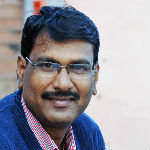 Born in 1971, Dr. Prabhakar studied Ancient Indian History and Archaeology at Madras University, then at the Institute of Archaeology, Archaeological Survey of India, Delhi, and obtained PhD from Kurukshetra University. He joined the Archaeological Survey of India in 1997 and served at its field offices in Agra and Aurangabad, later as Superintending Archaeologist at Aurangabad Circle and Excavation Branch, Delhi.
Born in 1971, Dr. Prabhakar studied Ancient Indian History and Archaeology at Madras University, then at the Institute of Archaeology, Archaeological Survey of India, Delhi, and obtained PhD from Kurukshetra University. He joined the Archaeological Survey of India in 1997 and served at its field offices in Agra and Aurangabad, later as Superintending Archaeologist at Aurangabad Circle and Excavation Branch, Delhi.
Dr. Prabhakar directed excavations at the Harappan sites of Rupnagar (2011-12) and Karanpura (2012-13 and 2013-14), and the medieval site of Daulatabad (2010), besides participating in excavations at Mehtab Bagh, Madarpur, Fatehpur Sikri, Sanauli (all four in Uttar Pradesh), Ellora (Maharashtra) and Kashipur (Uttarakhand). Using the multidisciplinary approach, he conducted metallurgical investigations of copper hoard specimens (from Madarpur), stable isotopic studies of human tooth enamel (from Sanauli), a study of ernestite drill bits (from Dholavira, Gujarat, and Karanpura, Rajasthan) and palaeoclimatic investigations (at Karanpura).
Dr Prabhakar has been on deputation to Indian Institute of Technology Gandhinagar since 2014 to develop its Archaeological Sciences Centre, in particular to set up various labs for the analysis of archaeological artefacts and for palaeoclimatic investigations based on archaeobotanical remains. He has published over 25 articles in peer-reviewed journals.
Abstract of the lecture
Glimpses of Harappan Society
The Harappan Civilization is one among the four Bronze Age Civilizations of third millennium BCE; it flourished for nearly 700 years (c. 2600 – 1900 BCE) in the river valleys of Indus-Ghaggar-Hakra in modern India and Pakistan. The research for over a century has led to a better understanding of the rise, growth and decline of Harappan civilization. The overall site count is now well over 2,500, belonging to all the three phases, viz., early Harappan, Harappan and late Harappan. The Harappan Civilization is characterized by well-planned-out cities, always with a fortification, often with more than two individually fortified divisions, standardized ceramic tradition, weighing system, seals and sealing and a wide variety of craft activities.
The Harappan society consisted of people of various professions such as agriculturists, pastoralists, merchants, nomads, fishermen, hunters, farmers, rulers, state officials, attendants, traders, shopkeepers, workshop owners, gate keepers, tax collectors, sweepers, garbage collectors, artisans, ritual specialists and other professionals. This can be inferred from various tangible and intangible archaeological evidences, which also indicate distinct localities in larger cities where specialized craftsmen lived for several generations.
This lecture presents a brief introduction to Harappan Civilization and its society as evidenced from excavations and geographical settings.
Readings
Material for study
- Peoples and Professions in Indus Civilization, Jonathan Mark Kenoyer
- Harappans and hunters, economic interaction in prehistoric India, by Gregory L. Possehl
Material for reference (optional reading)
- Socioeconomic structures of Indus Civilization, Jonathan Mark Kenoyer
- Wealth and socioeconomic hierarchies of Indus Civilization, Jonathan Mark Kenoyer